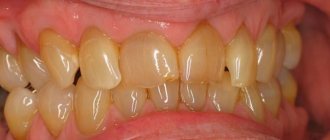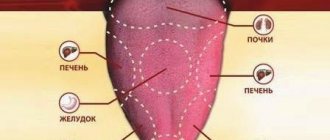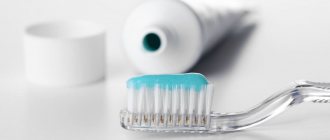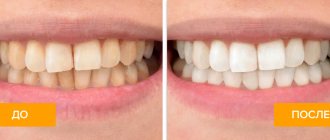How plaque forms
Tobacco tar and nicotine are deposited primarily on the teeth. The finely porous surface of the enamel promotes the rapid “attachment” of combustion products and gradually loses its natural color.
Teeth do not immediately become “black” (a common expression). First, the enamel tarnishes with the formation of a yellow coating, then it acquires a darker color, and only after that a noticeable brown pigment appears in the form of spots and stripes.
The process of plaque formation on teeth from smoking lasts more than one day. Microscopic food debris, saliva and tobacco tars gradually form a very strong chemical complex that is difficult to remove with a toothbrush and other means at hand. At first, whitening pastes can help, but over time they stop working.
Phosphorus and iron salts contained in saliva, when interacting with tobacco tars, actively deposit first on the root part of the tooth. A smoker’s smile is immediately visible - the main part of the plaque is concentrated in this place. In particularly advanced cases, teeth change color almost completely.
Smoker's plaque is the first step to the formation of stones, which can only be removed in the dentist's office.
Is it possible to smoke with sinusitis and what are the consequences?
According to doctors, smoking with sinusitis is strictly prohibited (even in minimal quantities).
This is not recommended for the reason that
acrid tobacco smoke has an irritating effect on the nasal sinuses , as a result of which the amount of mucus secreted (of which there is already a lot during illness) only increases, the nose becomes more stuffy, and it becomes even more difficult to blow your nose.
Thus, the mucus darkens and thickens, gradually accumulating in the nasal sinuses, which serves as a source of infection spreading through the tissues and blood vessels .
If a person neglects the recommendations of doctors and still continues to smoke, very soon one can expect serious consequences , for example:
- Spread of inflammation from the mucous membrane to the bone base - to the upper jaw. The result is acute pain that is practically uncontrollable by medication.
- Swelling of the eyeball with damage to its nerve and veins by thrombotic plaques , because the eyes are located in close proximity to the nasal sinuses.
- Infection of the brain followed by meningitis.
- Spread of infection to more distant organs (kidneys, liver, respiratory and endocrine systems).
Attention! Systemic inflammation and sepsis (infection of the entire body through the blood) are possible.
How smoking affects teeth
You can answer in one word - negative. The resulting tartar is particularly durable and actually grows into the enamel. Brown plaque is an ideal environment for the life of pathogenic flora, which causes a number of diseases, the most harmless of which can be called caries.
When smoking, the surface of the teeth gradually becomes rougher and more porous, the plaque on it hardens well and becomes more and more difficult to clean off every day. The enamel darkens and takes on a completely unsightly appearance.
A smoker can say “thank you” if he does not have a hereditary predisposition to periodontitis or periodontal disease. In this case, the picture takes on a completely deplorable appearance - the teeth become loose, are at different levels, and the roots may be exposed. Plus the dark brown color of the enamel and not just unpleasant, but disgusting, smell from the mouth.
An easy way to quit smoking. As soon as you “suddenly” made such a decision, leave a pack of cigarettes in your bag, pocket, or backpack. You will simply know that if you have an unbearable urge to smoke, cigarettes will be at your fingertips. The brain notes that there is a safety net and does not ask for nicotine. The method works.
How can we help you?
The Alfa-Dent dental clinic offers a wide range of procedures aimed at treating and preventing diseases of the dentofacial apparatus.
We offer you the following procedures:
- Veneering and lumineering;
- Comprehensive cleaning (ultrasonic removal of tartar, teeth polishing);
- Whitening (“Opalescence Xtra Boost”, “Air Flow”);
- Selection of aligners and preparations for home whitening;
- Treatment of periodontitis (depending on severity and stage);
- Treatment of caries.
If you smoke and are worried about possible dental problems, now is the time to prevent them. The specialists of the Alfa-Dent clinic will be happy to help you in the treatment and prevention of dental diseases.
How to get rid of plaque on teeth from smoking
Removing plaque from teeth will require some effort on the part of the smoker, the main one of which is regular oral hygiene. Using special toothpastes is rational at the very beginning, as it can slightly slow down the growth of deposits.
Some smokers try to use “proven” traditional medicine, but, as a rule, they also do not help. Tartar is a complex chemical complex consisting of phosphorus and iron salts and organic inclusions. Its special property is its extraordinary hardness and strong attachment to tooth enamel.
Only a dentist or hygienist can completely remove smoker’s plaque. Regular visits every six months will yield results - your teeth will look well-groomed and clean, and your smile will always be beautiful.
Why is tobacco considered harmful to the oral cavity?
For a long time, smoking was considered completely natural and safe, in fact, some experts even recommended tobacco to (supposedly) improve blood circulation and lung function. Everyone smoked: from ordinary peasants and workers to prominent politicians and movie stars of the first magnitude. The aestheticization of smoking was largely due to high-profile advertising campaigns and the activity of large corporations that could afford to spend millions to promote their products.
Experts spoke about the dangers of smoking in the 19th and early 20th centuries, but few listened to them. It was only in the second half of the twentieth century that the rise of diseases associated with excessive tobacco use and published research helped put the situation into perspective. Dentists were among those who drew attention to the dangers of smoking. Many studies have been conducted that have proven that smoking is one of the factors that provoke caries, periodontal inflammation and a number of other dental diseases.
Cigarettes contain hundreds of substances and components harmful to the oral cavity: nicotine, carcinogens, acetone, hydrocyanic acid, etc. “Smoker's teeth” have become one of the most common informal diagnoses in dentistry. This was also due to the fact that regular tobacco consumption was complemented by poor hygiene, poor diet and neglect of dental treatment. Someone will object and say that many smokers have completely healthy teeth and sometimes even a snow-white smile. This only means that a person makes great efforts to maintain dental health and has good genes, but in general this bad habit negatively affects the condition of the oral cavity and can still lead to problems and complications later.
Professional cleaning
Dentists offer several options to completely remove smoker’s plaque from teeth. Professional cleaning allows you to completely remove hardened deposits from the enamel and reduce the risks of caries and inflammatory gum diseases.
Types of professional dental hygiene:
- Mechanical cleaning. The doctor manually removes plaque with special scrapers. The work requires some effort, which is associated with possible damage to the enamel and gums. The method of mechanical cleaning is now almost never used precisely because of its traumatic nature.
- Dry cleaning. Special compounds containing acids and softening the stone are applied to the enamel. After curing, the plaque is removed. The method is notable for the fact that it allows you to simultaneously whiten your teeth. It is not recommended to constantly give preference to dry cleaning, since acids affect not only plaque, but also enamel.
- Ultrasonic cleaning. Using a special attachment, the doctor removes hard deposits that literally crumble under the influence of ultrasound. The main advantage of the technique is that it allows you to clean subgingival pockets (of particular importance if you are prone to periodontal disease and periodontitis). If your teeth are sensitive, anesthesia may be required. Ultrasonic cleaning makes it possible to remove all stones.
- Air-Flow. The principle of operation of the device is to supply a water-soda mixture to the teeth under pressure. The jet of the drug perfectly cleans the interdental spaces and subgingival pockets. Patients note a special feeling of freshness even during the procedure, after which the teeth become 1-2 shades lighter. No anesthesia is required.
- Laser cleaning. One of the most effective methods that allows you to remove smoker’s plaque as completely and painlessly as possible. The disadvantages of laser cleaning are the inability to clean subgingival pockets and high cost.
After cleaning, the teeth are ground and polished, the enamel becomes smoother, non-porous, which reduces the likelihood of rapid appearance of new plaque.
In practice, dentists use combined cleaning methods. The most common case is ultrasonic cleaning plus Air-Flow.
Possible diseases
Chemical toxic elements contained in large quantities in cigarettes cause irreparable harm to health. Nicotine and tar penetrate the dental tissue, disrupting the functioning of the body. In addition to darkening of the enamel, over time, smokers develop chronic inflammatory processes that develop into the following diseases:
- Caries . Gradual destruction of dental tissue, causing increased sensitivity and pain.
- Pulpitis . A disease in which the infection gets inside the tooth, where soft tissues, blood vessels and nerves are located. Usually develops when caries treatment is neglected.
- Gingivitis . Inflammation of the gums, in which the connection with the dentition is not broken. Accompanied by hypoxia and the formation of dense plaque. Without proper treatment, gingivitis develops into periodontitis.
- Granuloma . The disease occurs without symptoms. Accompanied by the appearance of painful redness and neoplasms.
- Periodontitis . An inflammatory process in the tissues of the oral cavity, leading to damage to the gums and bone tissue of the dentition.
- Periodontal disease . An advanced stage of periodontitis, in which the root system is exposed. The disease often leads to tooth loss.
Removing plaque at home
To remove smoker's plaque, you can try special cosmetic and hygiene products. They will undoubtedly not remove solid deposits, but they are quite suitable as a temporary measure. In any case, after using them, your teeth will look much better.
What smokers buy:
Whitening toothpastes. The most popular of them are Splat and Lacalut White. They can be used no more than twice a week, since the abrasive they contain contributes to the thinning of the enamel.
Trays with whitening gel. You can buy a ready-made White Light device, which includes a mouth guard, gel and a light lamp. In some cases, patients turn to specialists to make a mouth guard.
Whitening pens or strips. They have become widespread among smokers, but they must be used very carefully. Hydrogen peroxide is used as an active substance, which can also negatively affect the condition of the enamel. Some reviews voice darkening of teeth with too intensive use of products.
Gels. The most popular are Rocs, Global White, Colgate. It is possible to lighten the enamel by several tones. The gel contains hydrogen peroxide, so use should be limited.
Important. None of the listed remedies will remove plaque completely. There is no point in using them all the time, since they all lead to thinning of the enamel. It’s easier and more rational to go to the dentist once every six months - the result is better, the teeth are better.
Statistics
The World Health Organization has provided information according to which 15% of the world's population are smokers. Economically, smoking is very profitable; it brings annual profits to tobacco corporations in the amount of 700 billion US dollars. But such indicators are extremely expensive for humanity. Today, mortality among smokers is in first place. Every year this sad figure is 8 million people.
There is no "safe" tobacco
Serious health problems are caused by absolutely any form of tobacco. Both cigarettes and chewing tobacco or other smokeless tobacco products contain a lot of chemicals that are harmful to the human body. They cause problems such as: • Dependency. The main culprit of addiction is nicotine, and it is found in large quantities in cigarettes. • Caries. • Gum diseases. • Cardiovascular diseases. • Precancerous lesions of the mouth. • Cancer.
Folk remedies
Fans of traditional medicine and those who categorically do not want to go to the doctor can use “long-proven” methods of cleansing teeth from smoker’s plaque.
Important. The author of the article consulted with dental hygienists, and moreover, looked at several forums with reviews. It's up to you to decide, but some people need to step on their own rake.
So:
Soda is a favorite among smokers. Apply baking soda to a wet toothbrush and rub your teeth with it. A small effect is noticeable with a slight plaque; fossilized deposits cannot be processed. With frequent use, it threatens to thin the enamel.
Tooth powder is for amateurs. The viscous mass removes plaque and refreshes the oral cavity. Not everyone enjoys the process of brushing their teeth.
Fruit acids - you can use lemon slices, strawberries, green apples. Rub your teeth with them and rinse your mouth well. Good for freshening the mouth.
Tea tree oil - after brushing your teeth, apply a few drops of oil to the brush and rub the enamel with it. Rinse with water and lemon juice. There may be slight numbness in the gums.
Wood ash is often recommended, but suddenly you come across a pebble... In this case, it’s better to try activated carbon from the pharmacy. In any case, there is no risk of breaking teeth.
Hydrogen peroxide - applied to a cotton pad and rubbed onto the enamel. The gums must be protected. From reviews: with frequent use, the enamel becomes loose and dark, such a contradiction.
Over the past few years, smokers have come to the conclusion that it is easier and more effective to visit a dentist.
Problem No. 3: inflammation of the gums and ligaments of the tooth
Here too, everything starts small. The mucous membrane of the oral cavity, constantly receiving chemical and mechanical irritation, gives a response - it becomes inflamed. Interestingly, it is more difficult for smokers to notice the first signs of gingivitis (as well as caries) than for non-smokers. Because visible and basic signs of pathology are often absent. There is no bleeding gums, because... the effect of nicotine promotes compression of the terminal blood vessels and a slowdown in blood circulation - in the first minute1 the smoker’s blood flow sharply increases, then an acute decrease occurs. There are no painful sensations either, because... Injury to soft tissue occurs on an ongoing basis; they are already accustomed to it. A person is in blissful ignorance, and meanwhile nicotine weakens protective cells and destroys them, making its way deeper and deeper.
This bad habit can cause gum inflammation
People who smoke are susceptible to developing nicotine stomatitis, which occurs as a result of irritation of the mucous membranes by high temperatures. It manifests itself especially clearly at the beginning of the formation of a bad habit - the sky turns red, the ducts of the small salivary glands expand. Over the years, the mucous membrane of the palate thickens and becomes covered with a brownish-whitish “shell.”
Smokers often turn to doctors when they notice mobility of teeth and exposure of their roots, pain not only in the gums, but also in the teeth themselves, which indicates the development of periodontitis, which has a destructive effect on the ligamentous apparatus, leading to its destruction.
Prevention
To avoid possible unpleasant consequences, you should follow only two rules - brush your teeth regularly, using whitening pastes from time to time, and visit the dentist once every six months.
Smooth polished enamel prevents plaque from settling, leaving teeth looking well-groomed. With proper hygiene, the enamel does not have time to be “overgrown” with stones to such an extent that it reaches a terrible state within six months. The doctor's visit proceeds as usual, you can continue smoking. Although we highly recommend quitting.
Is it possible to smoke with flux and what are the consequences?
Smoking during flux is not recommended , because oxygen starvation of tissues occurs, which may result in complications of the following nature:
- An abscess is a cavity with purulent contents, causing acute pain when pressing on the gums, increased body temperature and swelling of the soft tissues in the affected area.
- Cellulitis is a dangerous complication of an abscess that can be fatal. Pus extends beyond the focus of inflammation and penetrates into other organs and nearby tissues.
- Sepsis - as a result of pus entering the bloodstream, the entire body becomes infected. The immune system is powerless in this case.
- Sinusitis - damage occurs to the paranasal sinuses (one or two at once), accompanied by severe pain at the site of inflammation and an increase in body temperature.
- Osteomyelitis of the jaw is a lesion of the soft tissues of the oral cavity, teeth and all levels of bone tissue at the site of inflammation.
And this is not a complete list of the consequences that arise when smoking during flux.
Alternatives to cigarettes that cause less harm
Thanks to steadily developing technologies, smokers today have a chance to make their addiction less dangerous and protect their oral cavity. For this purpose, various alternative means , for example:
- Electronic cigarettes - in some ways, the principle of operation of an electronic cigarette is similar to an inhaler. This device has a shape similar to the usual cigarettes and creates the illusion that a person is using a regular tobacco product. An electronic cigarette includes a battery, LED indicator, vapor generator, replaceable cartridge and other components.
- Hookah is equipment for smoking hookah mixtures and consists of a shaft, a flask (water is poured into it) and a cup (the smoking mixture is poured into it). Essentially, a person inhales aromatic smoke and thereby satisfies his habit.
- Patches create optimal conditions for the intake of purified nicotine into the body, which helps satisfy the daily need for smoking.
- POD systems are compact electronic cigarettes with a small battery, which are a disposable item. Very convenient to use.
- Sprays are recommended during the period of quitting an addiction; their principle of action is similar to nicotine patches. But in both cases, the nicotine component is used as replacement therapy (to prevent the development of withdrawal syndrome). Suitable for experienced smokers. Sprays are available both nasally and orally.
What is melanosis?
Smoker's melanosis is a change in the color of the oral mucosa caused by frequent smoking. Melanosis looks like a pigment spot of a light or brown hue , localized in the gum area of the lower jaw, on the palate or on the inner surface of the cheeks.
For your information! This pathology is not dangerous, but over time it can cause inflammation or swelling. Therefore, it is recommended to visit the dentist periodically.
How long after eating can you smoke?
To reduce the negative impact of tobacco smoke and nicotine on the body, it is recommended to smoke only 15-30 minutes after a meal (including after drinking tea, coffee or any other drinks).
Many smokers believe that their favorite habit helps burn calories and therefore prefer to smoke immediately after eating.
And this is true, but one cigarette can burn only 10 calories, and this causes enormous damage to the body (pathologies of the cardiovascular system, malignant tumors, etc. develop). Therefore, it is better not to smoke immediately after eating, but to wait at least 15 minutes .











